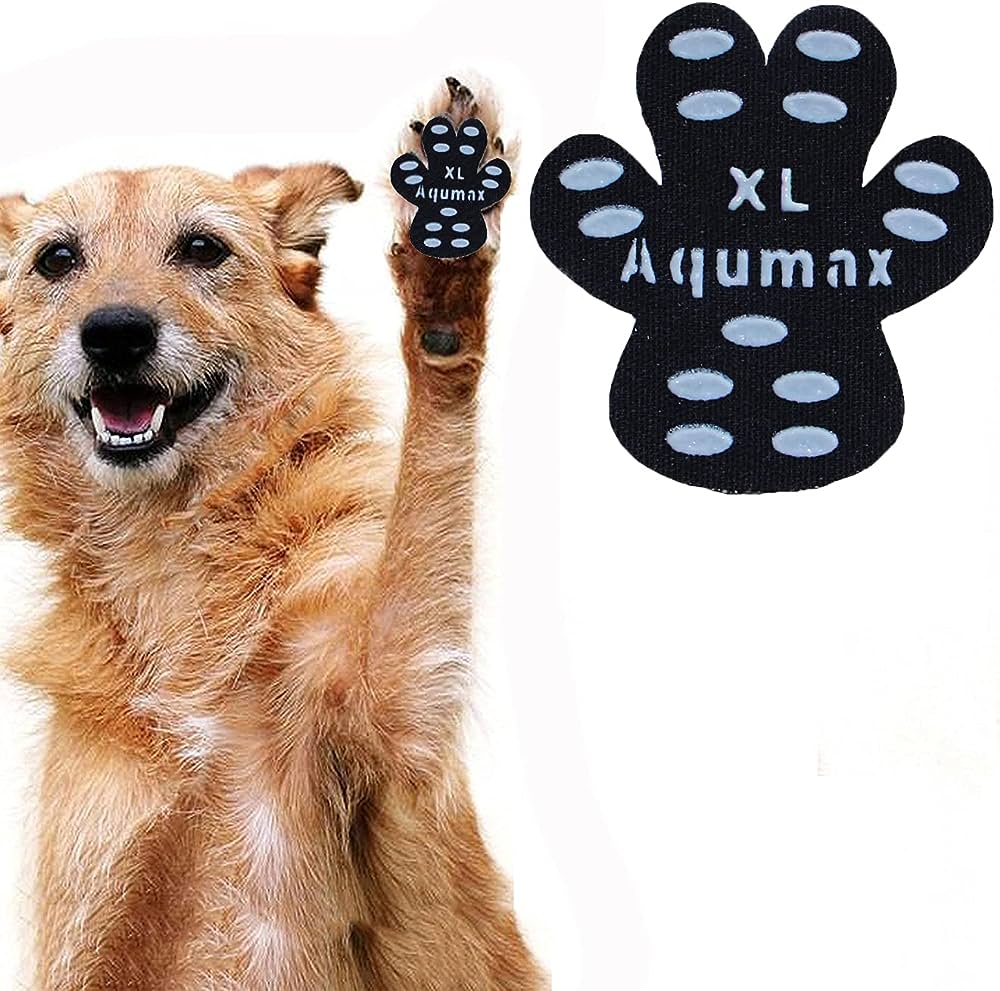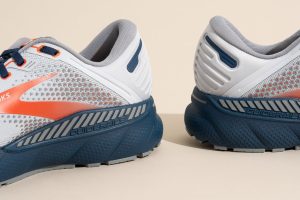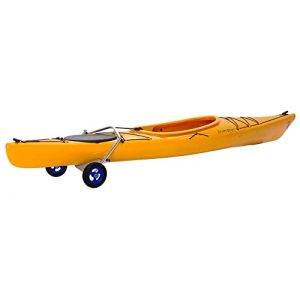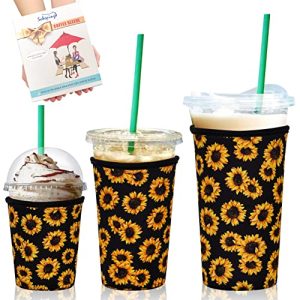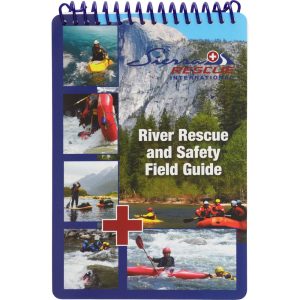Contents
- Why Dogs Slip On Certain Surfaces
- Understanding Sticky Pads For Dogs Paws
- Choosing The Right Sticky Pads For Your Dog
- The Application Process For Sticky Pads
- Maintaining And Caring For Sticky Pads
- Addressing Concerns And Faqs About Sticky Pads
- Alternatives To Sticky Pads For Dogs Paws
- Real-Life Success Stories Of Dogs Using Sticky Pads
- Frequently Asked Questions Of Sticky Pads For Dogs Paws
- Conclusion
Sticky pads for dogs’ paws are a practical and effective solution to prevent slipping and protect their feet. These pads provide traction and grip on slippery surfaces while also protecting their paws from hot pavement and harsh terrain.
They are easy to use, with a simple and adhesive design that sticks to the bottom of the paws without causing any discomfort or hindrance to their natural movement. Whether your dog is navigating smooth floors at home or going for a walk on rough outdoor surfaces, sticky pads can provide the extra stability and safety they need.
Say goodbye to slipping and sliding, and give your furry friend the confidence to explore with sticky pads for dogs’ paws.
Why Dogs Slip On Certain Surfaces
Dogs may slip on certain surfaces because of their paws lacking traction. Sticky pads provide a helpful solution by giving dogs grip and stability, preventing slips and falls.
Factors That Contribute To Dogs Slipping
Dogs slipping on certain surfaces can be attributed to several factors that affect their paw grip and stability. Here are some key factors to consider:
- Paw Pad Texture: The texture of a dog’s paw pads plays a significant role in their ability to maintain traction. Smooth or worn-out paw pads may struggle to grip smooth surfaces, leading to slips and falls.
- Nail Length: Overgrown nails can hinder a dog’s ability to gain traction on surfaces. The longer the nails, the more likely they are to slide or skid.
- Surface Type: Different surface types have varying degrees of grip. Dogs are more likely to slip on slick surfaces like hardwood floors, tile, or linoleum. These surfaces lack the natural roughness that provides traction.
- Moisture and Oil: Wet or oily surfaces can be particularly hazardous for dogs. The moisture or presence of oils can reduce paw pad grip and increase the likelihood of slipping.
- Physical Condition: Older dogs or those with joint issues and muscle weakness may experience more slips due to decreased stability and coordination.
The Impact Of Slipping On A Dog’S Health And Well-Being
Slipping can have adverse effects on a dog’s overall health and well-being. Here’s how it can impact them:
- Injuries: Frequent slipping can lead to injuries such as sprains, strains, or even fractures. These injuries can cause pain and discomfort, restricting the dog’s mobility and affecting their quality of life.
- Joint Problems: Slippery surfaces can put excessive strain on a dog’s joints, leading to conditions like arthritis. Chronic slipping can worsen joint problems and contribute to long-term mobility issues.
- Anxiety and Fear: Dogs that slip frequently may develop anxiety or fear-related behaviors, as their confidence in walking or running decreases. This can lead to a decrease in their overall happiness and mental well-being.
The Need For An Effective Solution To Prevent Slipping
Given the potential risks associated with slipping, it is crucial to find a viable solution to prevent accidents and promote paw grip. Here’s why an effective solution is needed:
- Safety: A reliable solution, such as sticky pads for dogs’ paws, can provide the necessary traction to prevent slips and falls. Ensuring a safe environment for your furry companion is of utmost importance.
- Physical Health: By preventing slipping, the solution can help minimize the risk of injuries and long-term joint problems in dogs.
- Emotional Well-being: By reducing slips, dogs can regain their confidence and alleviate anxiety-related behaviors. This contributes to their overall happiness and mental well-being.
Understanding the factors that contribute to dogs slipping, recognizing the impact on their health, and acknowledging the need for an effective solution is essential for providing our four-legged friends with a safe and comfortable environment.
Understanding Sticky Pads For Dogs Paws
Sticky pads for dogs’ paws provide support and grip, making it easier for them to walk on slippery surfaces. These non-slip pads are designed to protect dogs from sliding and falling, keeping them safe and comfortable during walks or playtime.
What Are Sticky Pads For Dogs’ Paws?
Sticky pads for dogs’ paws are innovative products designed to provide traction and prevent slipping on smooth surfaces. These adhesive pads work by adhering to the bottom of a dog’s paws, creating a non-slip grip that allows them to confidently walk, run, and play without the fear of sliding around or injuring themselves.
Made from soft and comfortable materials, these sticky pads are a simple yet effective solution for dogs with mobility issues or those who struggle with stability on slippery surfaces.
Here are the key points to know about sticky pads for dogs’ paws:
- Adhesive grip: Sticky pads feature a strong adhesive on one side that attaches to a dog’s paw pads, ensuring a secure grip on various surfaces.
- Non-toxic materials: Typically made from hypoallergenic and non-toxic materials, these pads prioritize the safety and comfort of our furry friends.
- Easy to apply and remove: Sticky pads are designed to be easily applied and removed without causing any discomfort to dogs. The adhesive is gentle and doesn’t leave any residue on their paws.
- Versatile usage: Sticky pads can be used in various situations, such as on hardwood floors, tiles, laminate, or even outdoor decks or ramps, to give dogs stability and confidence in their movements.
How Do Sticky Pads Work?
Sticky pads for dogs’ paws work by providing an extra layer of grip and traction. Here’s how they work:
- Adhesion: The sticky pads have an adhesive side that sticks directly to a dog’s paw pads, creating a secure bond that prevents slipping and sliding.
- Increased traction: The texture of the pads enhances traction by creating friction between the paw and the surface, allowing dogs to maintain better stability and control while walking or running.
- Protection: They act as a protective barrier, shielding sensitive paw pads from sharp objects, hot pavements, icy surfaces, or rough terrains.
- Comfortable and lightweight: Sticky pads are designed to be lightweight and comfortable for dogs to wear. The soft and flexible materials allow natural movement without restricting or causing discomfort.
- Reusable: Some sticky pads are reusable, making them a cost-effective and environmentally friendly option for long-term use.
Benefits Of Using Sticky Pads For Dogs
Sticky pads for dogs’ paws offer several benefits to both dogs and their owners. Here are some advantages of using these paw-friendly accessories:
- Injury prevention: By providing additional traction, sticky pads help prevent slips, falls, and related injuries on slippery surfaces, especially for senior dogs or those with mobility issues.
- Increased confidence: Dogs gain confidence and feel more secure when they have better stability and grip on unstable surfaces, allowing them to navigate their surroundings with ease.
- Protects paw pads: The pads act as a protective barrier, shielding sensitive paw pads from harsh or abrasive surfaces and reducing the risk of cuts, blisters, or burns.
- Versatile usage: Sticky pads are suitable for indoor and outdoor use, making them practical for various environments like homes, parks, or even during hikes and walks on different terrains.
- Easy to clean: Most sticky pads are washable, allowing for effortless cleaning and maintenance. Simply wash the pads and let them air dry for reuse.
Sticky pads for dogs’ paws provide an excellent solution for enhancing traction, preventing slips, and ensuring the safety and well-being of our furry companions. These paw-friendly accessories offer numerous benefits and are easy to apply, remove, and clean. Give your dog the confidence to walk and play on any surface with the help of these innovative sticky pads.
Choosing The Right Sticky Pads For Your Dog
Find the perfect sticky pads for your dog’s paws with our helpful guide. Discover the key factors to consider when choosing sticky pads to ensure your dog’s comfort and safety.
Factors To Consider When Selecting Sticky Pads
When it comes to choosing the right sticky pads for your dog, there are several factors to consider. These factors will help ensure that the pads you select are effective and comfortable for your furry friend. Here are the key considerations:
- Material: Look for sticky pads made from high-quality, non-toxic materials that are safe for your dog’s paws. Avoid pads that contain harmful chemicals or adhesives that could irritate your dog’s skin.
- Durability: Consider the durability of the sticky pads, especially if your dog is active or spends a lot of time outdoors. Opt for pads that are designed to withstand wear and tear, providing long-lasting protection.
- Grip Strength: Pay attention to the grip strength of the sticky pads. Look for pads that provide sufficient traction to prevent slipping and sliding, especially on smooth surfaces like hardwood or tile floors.
- Breathability: It’s important to choose sticky pads that allow your dog’s paws to breathe. Look for pads that have small perforations or a breathable design to prevent moisture build-up and promote comfort.
- Ease of Application and Removal: Consider how easy it is to apply and remove the sticky pads. Pads that feature a simple peel-and-stick design are convenient and hassle-free.
- Hypoallergenic Options: If your dog has sensitive skin or allergies, it’s worth considering hypoallergenic sticky pads. These pads are specially formulated to minimize the risk of skin irritation or allergic reactions.
Different Types Of Sticky Pads Available In The Market
When it comes to sticky pads for your dog’s paws, there are different types available in the market. Each type offers unique features and benefits. Here are the common types of sticky pads you’ll come across:
- Adhesive Gel Pads: These pads are made from a sticky gel material that adheres to your dog’s paws. They provide reliable traction and are reusable, making them a cost-effective option.
- Disposable Adhesive Sheets: These sticky sheets are designed to be placed on your dog’s paws and then discarded after use. They are convenient for occasional use or when you’re traveling with your dog.
- Traction Socks: Traction socks are like regular socks but with a non-slip sole. They are a popular choice for dogs that need extra grip on slippery surfaces. However, they may not be suitable for all dogs, especially those with long nails.
- Adhesive Paw Pads: These are small, pre-cut sticky pads that can be applied directly to your dog’s paws. They provide traction and protection and are often available in different shapes and sizes to suit various breeds.
Size And Fit Considerations For Optimal Effectiveness
Choosing the right size and ensuring a proper fit is crucial for the optimal effectiveness of sticky pads for your dog’s paws. Consider the following size and fit considerations:
- Measure Your Dog’s Paw Size: Before purchasing sticky pads, measure your dog’s paw size to determine the appropriate pad size. Look for pads that match the measurements to ensure a snug fit.
- Adjustable Straps or Fasteners: Some sticky pads come with adjustable straps or fasteners to help achieve a secure fit. These can be useful for dogs with different paw sizes or for added stability.
- Breeds and Paw Shapes: Different dog breeds and paw shapes may require specific sizing or shape options. Consider the unique characteristics of your dog’s breed or paw shape when selecting sticky pads.
- Range of Motion: Ensure that the sticky pads allow your dog to maintain a natural range of motion. They should not restrict movement or cause discomfort when your dog walks or runs.
- Check for Proper Placement: Once the sticky pads are applied, check for proper placement and ensure that they cover the paw pads completely. This will provide maximum traction and protection.
Keep these size and fit considerations in mind to ensure that the sticky pads you choose are comfortable and effective for your dog’s paws.
The Application Process For Sticky Pads
Discover the seamless application process for sticky pads designed specifically for dogs’ paws. These innovative pads provide traction and protection without leaving any residue behind.
Preparing Your Dog’S Paws For Application
- Gently clean your dog’s paws with a damp cloth to remove any dirt or debris that could affect adhesion.
- Trim your dog’s nails, ensuring they are not too long and won’t interfere with the sticky pads.
- If your dog has excessive fur on their paws, consider trimming it to improve contact between the sticky pads and their skin.
- If your dog has any cuts or irritations on their paws, wait until they are fully healed before applying the sticky pads to avoid discomfort.
- Make sure your dog is calm and relaxed before starting the application process to avoid any unnecessary stress.
Step-By-Step Guide To Applying Sticky Pads
- Start by selecting the appropriate size of sticky pad for your dog’s paws. The pads should cover the entire paw pad without extending onto the fur.
- Peel off the backing from the sticky pad, exposing the adhesive side.
- Carefully place the sticky pad on the center of your dog’s paw pad, ensuring that it is applied evenly.
- Gently press down on the pad, ensuring that it adheres well to the paw.
- Repeat the process for each of your dog’s paws, ensuring consistent placement and secure adhesion.
- Allow your dog to walk around and get used to the sticky pads. Monitor their comfort level to ensure the pads are not causing any discomfort or irritation.
- If your dog’s pads become dirty or lose adhesion over time, carefully remove the pads and replace them with new ones. Regularly check for wear and tear to ensure optimal performance.
Tips For Ensuring Proper Adhesion And Longevity
- Make sure your dog’s paws are clean and dry before applying the sticky pads to ensure optimal adhesion.
- Avoid applying the pads to wet or sweaty paws, as moisture can affect adhesion.
- If your dog tends to sweat excessively, consider using a paw drying powder or applying a thin layer of paw wax to improve adhesion.
- Trim any excess fur around the edges of the sticky pads to prevent them from peeling off prematurely.
- Monitor your dog’s paw pads regularly for any signs of irritation or discomfort. If you notice any redness, swelling, or sores, remove the sticky pads immediately and consult with your veterinarian.
- When changing the sticky pads, make sure to clean your dog’s paws thoroughly to remove any adhesive residue.
- Store the sticky pads in a cool and dry place to maintain their adhesiveness.
- Follow the manufacturer’s instructions regarding the recommended frequency of pad replacements for optimal performance.
Remember, ensuring proper adhesion and longevity of sticky pads is crucial for your dog’s comfort and overall paw health. By following these steps and tips, you can help protect your dog’s paws and enhance their paw pad traction.
Maintaining And Caring For Sticky Pads
Maintaining and caring for sticky pads for dogs’ paws is essential to ensure their comfort and prevent any discomfort or injuries. Regularly clean the pads, trim the hair around them, and avoid using harsh chemicals or rough surfaces to preserve their adhesive properties and keep the pads in good condition.
Cleaning And Maintaining The Sticky Pads:
Taking care of your dog’s sticky pads is crucial for their overall comfort and well-being. Regular cleaning and maintenance can help keep the pads in excellent condition and ensure that they provide the necessary grip and protection. Here are some tips on how to clean and maintain your dog’s sticky pads:
- Use lukewarm water and mild soap: Gently wash your dog’s paws with lukewarm water and a mild soap specifically formulated for pets. Avoid using harsh chemicals or strong detergents that can be irritating to their sensitive pads.
- Wipe dry after cleaning: After washing, pat your dog’s paws dry with a soft towel. Make sure to remove any moisture between the pads to prevent bacterial or fungal growth.
- Regularly inspect for debris: Check your dog’s paws for any debris, such as dirt, grass, or small stones, that may have gotten stuck between the pads. Use your fingers or a pair of tweezers to safely remove any foreign objects.
- Trim excess hair: If your dog has long hair around their paw pads, it’s important to keep it well-trimmed. Excessive hair can hinder the stickiness of the pads and accumulate dirt and debris more easily.
- Moisturize when needed: In some cases, your dog’s pads may become dry or cracked. Consult with your veterinarian for a suitable paw moisturizer or balm to keep the pads hydrated and supple.
- Avoid abrasive surfaces: While sticky pads provide excellent traction, it’s best to avoid walking your dog on excessively rough or abrasive surfaces that can wear out the pads more quickly.
- Regularly check for wear and tear: Over time, the stickiness of the pads may diminish or the pads may start to show signs of wear and tear. Inspect the pads regularly and replace them when necessary to ensure your dog maintains optimal grip and protection.
How Often Should The Pads Be Replaced?
Knowing when to replace the sticky pads on your dog’s paws is essential for maintaining their effectiveness. While the exact time frame may vary depending on factors such as your dog’s activity level and the quality of the pads, here are some general guidelines:
- Monitor wear and tear: Regularly check the condition of the sticky pads for any signs of wear and tear. If you notice significant cracks, loss of stickiness, or visible deterioration, it’s time to replace them.
- Consider your dog’s activity level: Dogs that are highly active or frequently engage in activities like hiking, running, or agility training may wear out their pads faster. In such cases, you might need to replace the pads more frequently.
- Follow manufacturer’s recommendations: Different brands and types of sticky pads may have specific instructions on when to replace them. Always refer to the manufacturer’s guidelines to ensure you’re providing the best care for your dog’s paws.
- Consult with your veterinarian: If you’re unsure about when to replace the pads or if your dog shows signs of discomfort, it’s best to consult with your veterinarian. They can assess your dog’s specific needs and provide personalized recommendations.
Remember, maintaining the stickiness and integrity of the pads is crucial for your dog’s safety and comfort. By regularly cleaning, inspecting, and replacing the pads when needed, you can ensure that your furry friend enjoys optimal paw protection and traction.
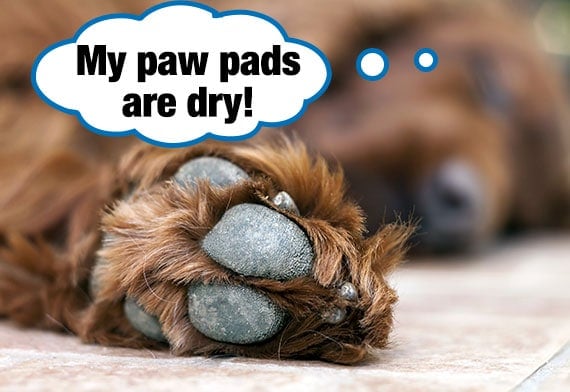
Credit: doglab.com
Addressing Concerns And Faqs About Sticky Pads
Looking for answers about sticky pads for dogs’ paws? Find out everything you need to know about addressing concerns and FAQs in this informative guide.
Sticky pads for dogs’ paws have gained popularity as a solution for various issues related to their mobility and comfort. However, it’s natural to have concerns and questions about using sticky pads on your furry friend. In this section, we will address common concerns about sticky pads and provide answers to frequently asked questions.
Can Sticky Pads Cause Allergies In Dogs?
- Sticky pads are typically made from hypoallergenic materials, reducing the risk of allergies.
- However, some dogs may have sensitivities to certain materials, so it’s important to monitor their reaction.
- If your dog shows signs of an allergic reaction, such as redness, itching, or swelling, discontinue use and consult with a veterinarian.
Can Sticky Pads Be Used For Dogs With Medical Conditions?
- Sticky pads can be beneficial for dogs with medical conditions, but it’s crucial to consult with a veterinarian before using them.
- Conditions such as arthritis, hip dysplasia, or paw injuries may benefit from the added traction and stability provided by sticky pads.
- However, individual cases may vary, and professional advice is necessary to ensure the pads are suitable for your dog’s specific condition.
Do Sticky Pads Hinder A Dog’S Natural Movement?
- Sticky pads are designed to provide extra grip and traction, not hinder a dog’s natural movement.
- When properly fitted, the pads allow dogs to walk, run, and play comfortably, while reducing the risk of slipping or sliding on slippery surfaces.
- It’s important to choose sticky pads that are appropriately sized, ensuring they do not restrict the dog’s paw movement or cause discomfort.
Sticky pads for dogs’ paws can be a valuable tool to enhance their mobility and overall well-being. However, it’s crucial to consider individual factors such as allergies and medical conditions before using them. By consulting with a veterinarian and choosing the right products, you can provide your furry companion with the support they need for a happy and active lifestyle.
Alternatives To Sticky Pads For Dogs Paws
Looking for alternatives to sticky pads for your dog’s paws? Explore a range of paw protection options that offer comfort and prevent slipping, such as paw balms, booties, and paw wax. These alternatives ensure your furry friend stays safe and can enjoy their walk or outdoor activities.
Sticky Pads for Dogs Paws can be a great way to prevent slipping on smooth surfaces and protect your furry friend’s paws. However, they may not be the ideal solution for everyone. In this section, we will explore some alternatives to sticky pads for dogs’ paws, the pros and cons of these options, and how they compare to sticky pads.
Other Methods Of Preventing Slipping On Surfaces:
- Paw Wax: Applying paw wax on your dog’s paws creates a barrier that helps with traction on slippery surfaces. It is easy to apply and provides a natural grip. However, it may wear off quickly and need reapplication.
- Paw Traction Socks: These are specially designed socks with rubberized grips on the bottom that provide traction on smooth surfaces. They are washable and reusable, but can wear out over time.
- Sandpaper Paw Pads: Attaching sandpaper to your dog’s paw pads improves traction. It is a cost-effective option, but the rough texture may cause discomfort for some dogs.
- Nail Trimming: Regularly trimming your dog’s nails can prevent slipping, as long nails can affect their grip on surfaces. However, it’s important to be cautious and not trim them too short to avoid pain or injury.
Pros And Cons Of Alternative Solutions:
Paw Wax:
- Pros: Easy to apply, natural grip, and provides temporary traction.
- Cons: May wear off quickly and require frequent reapplication.
Paw Traction Socks:
- Pros: Washable and reusable, comfortable for dogs, and offer good traction.
- Cons: Can wear out over time and may be difficult to put on for some dogs.
Sandpaper Paw Pads:
- Pros: Cost-effective solution, improves traction effectively.
- Cons: Rough texture may cause discomfort for some dogs, may need replacement frequently.
Nail Trimming:
- Pros: Prevents slipping by maintaining proper grip, cost-free solution.
- Cons: Requires regular maintenance, can be difficult to trim nails for some dogs.
How Do Sticky Pads Compare To Other Options?
Sticky Pads:
- Pros: Easily adhere to the paws, provide excellent grip, and durable for long-term use.
- Cons: May require trimming your dog’s fur for proper application, can be challenging to remove, and may limit paw flexibility.
In comparison to other alternatives, sticky pads offer a more secure and long-lasting solution for preventing slipping on smooth surfaces. While other options have their own benefits, sticky pads provide a strong grip and durability that can be especially beneficial for active dogs or those with mobility issues.
Remember, each dog is unique, so consider their comfort level, activity level, and specific needs when choosing the best alternative solution.
Real-Life Success Stories Of Dogs Using Sticky Pads
Discover the inspiring real-life success stories of dogs who have experienced the benefits of using sticky pads for their paws. These gripping solutions have transformed their lives, allowing them to navigate surfaces with ease and confidence.
Testimonials From Dog Owners Who Have Used Sticky Pads:
- Sarah: “I was at my wit’s end with my dog, Buddy, who had a constantly slipping problem on our hardwood floors. I decided to try sticky pads, and the difference it made was incredible. Now, Buddy can confidently walk around without any slips!”
- Mark: “I have a senior dog named Max, who was struggling to move around freely due to his slipping issues. After hearing about sticky pads, I gave them a try. I can’t express how relieved I am to see Max regain his confidence and independence.”
- Lisa: “My energetic pup, Bella, could hardly contain her excitement whenever she slipped around the house. Sticky pads have been a game-changer for us, providing a secure grip that allows Bella to run and play without any accidents.”
Before And After Experiences Of Dogs With Slipping Issues:
- Slippery Surfaces:
- Dogs struggling to maintain their balance on hardwood, tile, or laminate surfaces.
- Regular falls and injuries due to lack of traction.
- Improved Stability with Sticky Pads:
- Enhanced grip and stability for dogs on slippery surfaces.
- Reduced slipping incidents and a decreased likelihood of injuries.
- Increased confidence and freedom of movement.
How Sticky Pads Have Improved Dogs’ Quality Of Life:
- Easier Mobility:
- Dogs can move freely without the fear of slipping or falling.
- Improved ability to navigate around the house, including stairs and slippery areas.
- Enhanced Activity Levels:
- Dogs are no longer limited in their movements, encouraging them to be more active and playful.
- Increased exercise opportunities resulting in improved overall health and weight management.
- Stress Relief:
- Sticky pads provide dogs with a sense of security and comfort.
- Dogs can relax and enjoy their surroundings without the constant worry of slipping.
- Happy Interactions:
- Dogs can engage in social activities with family members and other pets without the fear of accidents.
- Improved interactions and bonding with owners, leading to happier and healthier relationships.
- Long-Term Benefits:
- By preventing slips and falls, sticky pads help maintain dogs’ joint health and prevent injuries.
- Improved quality of life and overall well-being for both dogs and their owners.
Remember, using sticky pads can significantly improve a dog’s life by providing stability, reducing injuries, and bringing back their playful spirit. Testimonials from dog owners reflect how effective these pads have been in real-life situations, transforming the lives of dogs with slipping issues.
Frequently Asked Questions Of Sticky Pads For Dogs Paws
Are Adhesive Paw Pads Safe For Dogs?
Yes, adhesive paw pads are safe for dogs.
Do Stick On Paw Pads Work?
Stick-on paw pads can be effective in protecting your pet’s paws. These adhesive pads provide a layer of cushioning and grip, preventing slips and falls on slick surfaces. They can also protect against hot pavements, sharp objects, and cold weather.
Stick-on paw pads are easy to apply and remove, making them a convenient and temporary solution. However, their effectiveness may vary depending on the size and activity level of your pet. It’s important to choose pads that are the right size and thickness for your furry friend.
Regular inspection and replacement of worn-out pads are necessary to ensure continued protection. Overall, stick-on paw pads can be a practical and helpful solution to protect your pet’s paws in certain situations.
What Is The Best Thing To Put On A Dog’S Paws?
The best thing to put on a dog’s paws are paw balms or dog-specific moisturizers. These products help protect their paws from dryness and cracking. Regular application can keep their pads moisturized and prevent discomfort. It is important to use products formulated specifically for dogs, as human products may contain ingredients that can be harmful to them.
Additionally, keeping your dog’s paws clean and dry after walks or outdoor activities can also help maintain their paw health. Regular paw inspections can help identify any cuts, debris, or irritations that may need immediate attention. Remember to consult with your veterinarian if you notice any persistent issues or if your dog shows signs of discomfort.
Can I Put Vaseline On My Dog’S Paw Pads?
Yes, you can apply Vaseline on your dog’s paw pads. Vaseline acts as a protective barrier, preventing excessive dryness, cracks, and infections. It helps soothe and moisturize your dog’s paws, especially during extreme weather conditions. However, ensure that your dog doesn’t lick off the Vaseline, as ingesting large amounts can cause stomach upset.
To apply it, clean your dog’s paws and gently massage a thin layer of Vaseline onto the pads. Consider using dog-safe products specifically made for paw care, as they may provide additional benefits. Regularly inspect your dog’s paws for any signs of irritation or injury.
If you notice any problems persist or worsen, consult your veterinarian for further guidance.
Conclusion
Sticky pads for dogs’ paws are a game-changer in the world of pet care. These paw pads not only provide protection but also offer much-needed relief for our furry friends. With their anti-slip and waterproof qualities, they ensure dogs can walk comfortably on any surface.
Say goodbye to slips and slides on slippery floors or hot pavements during the summer months! Additionally, sticky pads are easy to use and can be cut to fit any paw size. They are also reusable, making them an eco-friendly option for dog owners.
Whether you have an active dog that loves outdoor adventures or a senior dog in need of extra support, sticky pads are a reliable solution. Give your furry friend the comfort and confidence they deserve with these innovative paw protectors.
Say hello to happy and healthy paws!

